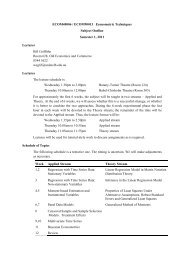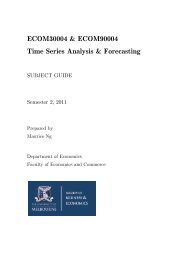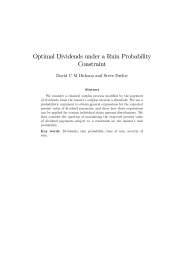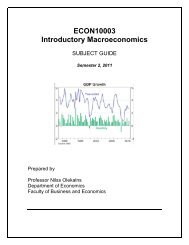A Model of Optimal Corporate Bailouts - Faculty of Business and ...
A Model of Optimal Corporate Bailouts - Faculty of Business and ...
A Model of Optimal Corporate Bailouts - Faculty of Business and ...
Create successful ePaper yourself
Turn your PDF publications into a flip-book with our unique Google optimized e-Paper software.
As long as the firm reinvests, sv ∗ 2 ( g, T 2 ) is invariant in g, <strong>and</strong> strictly decreasing in T 2 . Moreover,Bayesian perfection also requires sequential rationality from the government, so that g, T 2 , F G must remain optimal at time 2. This leads to the following theorem:Theorem 1 The optimal bailout policy sets T ∗ = 0. Moreover, the optimal bailout pays a positive2subsidy g ∗ only if R 2 /(4·c) − I 2 < 0, <strong>and</strong> sets g ∗ = I 2 − R 2 /(4·c), so that the firm earns zerocontinuation rents, i.e., π ∗( 2 g∗ , T ∗ ) = 0. 2(All lemmas <strong>and</strong> theorems are proven in the Appendix.) Although it is surprising at first thatT 2 = 0, the intuition is straightforward. Any marginal increase in T 2 inefficiently reducesmanagerial effort. As T 2 increases, the tax distortion causes firm pr<strong>of</strong>its to fall even fasterthan tax revenues rise, sharpening the government’s balance budget constraint. Consequently,the government can do no better than to drive T 2 to zero, <strong>and</strong> instead to finance any bailoutentirely by time 1 tax revenues (<strong>and</strong> paying out the residual bailout surplus, if any, as a cashgrant to the firm or other members <strong>of</strong> society). In contrast, although T 1 also distorts first-periodeffort, it does not necessarily do so in a self-defeating way, because T 1 is not capitalized intothe required bailout subsidy. 14This insight in turn provides the basis for the second part <strong>of</strong> Theorem 1. <strong>Optimal</strong> bailoutsmust raise revenue solely from T 1 , but the distortions caused by T 1 > 0 are socially costly aswell. Any optimal bailout should avoid “overfunding” the minimal subsidy needed to inducecontinuation. Consequently, an optimal bailout must set both g <strong>and</strong> T 1 to the lowest amountthat prevents closing. It also implies that the optimal policy does not subsidize firms that wouldreinvest without government intervention (i.e., those for whom π ∗ 2 ( 0, 0 ) = R2 /(4·c) − I 2 ≥ 0).Therefore, Theorem 1 also states that when the optimal bailout involves a positive transfer, itsets g to be I 2 − R 2 /(4·c), just enough to induce reinvestment but leaving the existing ownerswith zero continuation pr<strong>of</strong>its. (In practice, this would <strong>of</strong>ten be done through expropriation ina formal Chapter 11 bankruptcy.)A direct implication <strong>of</strong> Theorem 1 is that any feasible bailout funded entirely by T 2 (withT 1 = 0) is worse than a government non-intervention policy. This is because any bailout thatis funded entirely by T 2 revenues can only bail out firms that would restart on their own, i.e.,without any assistance (or tax) from the government.Collecting results from the analysis <strong>of</strong> time 2, interim incentive <strong>and</strong> participation constraintsreduce to the following conditions:w ∗ = R 22 , e∗ = R 0 if π∗22·c , T ∗ = 0, 2 g∗ 2=( 0, 0 ) ≥ 0 −π 2 ( 0, 0 ) if π ∗( 0, 0 ) < 0 , ρ∗ = IN if π ∗( 2 g∗ , T ∗ ) ≥ 0 22OUT otherwise2where π 2 ( 0, 0 ) = R 2 /(4·c) − I 2 . We will impose these conditions in the analysis <strong>of</strong> the time 1behavior that now follows.,14 This result contrasts with the st<strong>and</strong>ard “Ramsey pricing” intuition in optimal tax literature, where the taxes ontwo activities (here time 1 <strong>and</strong> 2 production) would be set to equilibrate marginal efficiency costs.13
















